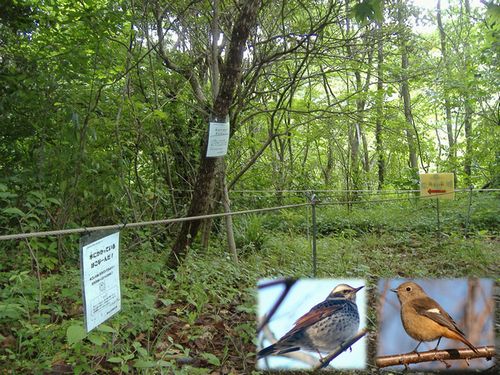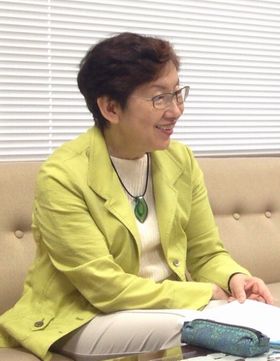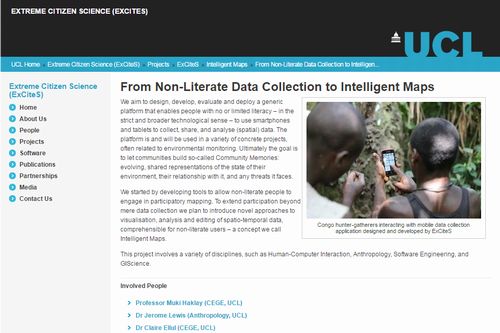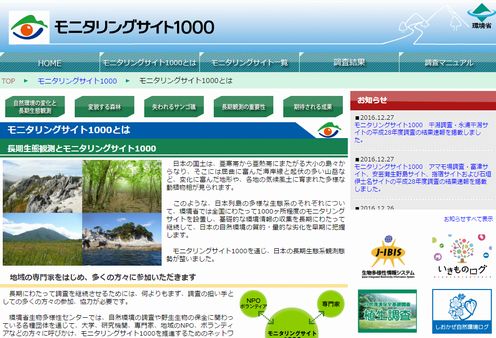January 19, 2017
Citizen Science: How Anyone Can Be Involved in Solving Environmental and Social Issues
Keywords: Civil Society / Local Issues Ecosystems / Biodiversity Education Newsletter
JFS Newsletter No.172 (December 2016)

Yokohama Nature Sanctuary and Dusky Thrush (left) Daurian redstart (right)
Photo by Yo-sei_Shoshi, Materialscientist, Alpsdake Some Rights Reserved.
There are various environmental and social issues, the solutions to which require the cooperation of the public as well as the expertise of professionals. As an active practitioner in environmental fields, Representative Director Hiromi Kobori of the General Incorporated Association of the Biodiversity Academy--also a distinguished professor at Tokyo City University--keeps a watchful eye on trends in citizen science, because it has the potential to help the public contribute to society in a more scientific manner.
Japan for Sustainability interviewed Prof. Kobori, asking her to describe citizen science along with its potentials and future tasks, and give us some case examples. This month's JFS newsletter introduces citizen science.
Defining 'Citizen Science'

Prof. Hiromi Kobori Photo by JFS.
Have you heard of "citizen science"? This concept has existed since the time of Aristotle, the fourth century BC Greek philosopher, and has been defined variously. In recent years, a definition as "citizen involvement in scientific research" has taken root globally. The position of "scientist," however, has been formally established and developed into a professional job since about the 19th century. Therefore, opportunities for citizen involvement in science have long vanished. Probably many people would rather avoid the subject of science altogether.
Recent developments in information technology, however, have provided a technical system that allows citizens to contribute to science on a daily basis. When trying to ascertain specific trends triggered by various influences from environmental changes such as global warming, biodiversity loss, earthquakes and natural disasters, in conducting surveys, researchers and administrative offices have a limited data-collection capacity. In this respect, monitoring with the purpose of accumulating long-term data with broad geographical diversity plays an important role. When large numbers of citizens are engaged in crowdsourcing to collect data using GPS locator-equipped cell phones, vast amounts of data can be easily assembled.
Case Examples from Overseas
Let's look at some specific examples of citizen science.
In the Republic of the Congo, even women who cannot read can join a data collection project by helping to provide photographic data on illegal hunts and logging in forests. Researchers then analyze the data and create maps that are utilized in managing forest conservation. As this case shows, even people disadvantaged in literacy can contribute to science.

Extreme Citizen Science, University College London website
https://www.ucl.ac.uk/excites/projects/excites-projects/intelligent-maps/intelligent-maps
In Europe, lively exchanges of information occur between the public and scientists via the Internet. Previously, data collected by the public were viewed with skepticism due the allegedly low degree of accuracy. As projects collaborating with the public have expanded, however, peer-reviewed research papers written based on citizen science have increased year-by-year in the United States, giving the highly effective use of citizen science more prominence.
http://theoryandpractice.citizenscienceassociation.org/about/
Citizen Science in Japan
In Japan, citizen science has a long history, and various examples exist. Well-known ongoing cases include: a sea turtle survey which gathers data annually on numbers of sea turtles laying eggs on beaches across Japan and was launched in 1960s and 70s as a pioneering case of collaboration between scientists and citizens in Japan; and a dandelion mapping survey in the western part of Japan, which started in 1974.
The Ministry of the Environment of Japan has embarked on a national project called "Monitoring Sites 1000" to collect basic environmental information through long-term (100-year) monitoring of about 1,000 sites representing various ecosystems nationwide. The project aims to detect qualitative and quantitative deterioration at early stages in Japan's ecosystems. The project's website introduces many citizens groups across Japan participating in this project.

Monitoring Sites 1000 wbsite (Japanese)
The Center for Ecological Education, a Japanese non-profit organization, has launched the "Garden Wild Life Watch," a nationwide survey targeting private home gardens, including porches and balconies. With the aim of conserving biodiversity, it is an ongoing joint project involving the Ministry of the Environment, businesses and universities, and is the first attempt of its kind in Japan.
Garden Wild Life Watch
http://www.wildlife.ne.jp/ikimono/ (in Japanese)
Recent Citizen Science Initiatives in Japan
The average temperature in Yokohama, Kanagawa Prefecture has risen by 0.9 degrees Celsius in the 23 years since 1986 due to various factors, including the heat-island effect. The temperature there is rising at a pace three times as fast as temperatures around the world, where global warming is the cause.
In Yokohama, the Wild Bird Society of Japan has enlisted the cooperation of citizen volunteers and municipal staff in collecting data on birds appearing in the Yokohama Nature Sanctuary, a public forest area. These are compiled in a database on observation records of birds migrating to the sanctuary. Using the data in these observation records, the Kobori Laboratory at Tokyo City University has identified changes in patterns of migratory birds visiting the Yokohama area. The lab team picked out six bird species that come to the sanctuary every winter, and analyzed the related data for the 23 years since 1986. They chose the dusky thrush (Turdus eunomus), Daurian redstart (Phoenicurus auroreus), pale thrush (Turdus pallidus), black-faced bunting (Emberiza spodocephala), hawfinch (Coccothraustes coccothraustes) and Eurasian bullfinch (Pyrrhula pyrrhula).
Their research revealed apparent changes in migration timing patterns of all six species during the past 23 years. The day they first appear in Yokohama in autumn has shifted nine days later on average. The day they are last seen in Yokohama in spring has shifted 21 days earlier. In other words, the period of their stay in Yokohama has decreased by one month on average.
Professor Kobori says, "We had expected that they might be staying in Japan shorter than before but we were surprised to see how much shorter: by one-month! Observing birds around us provides us knowledge about global environmental changes." Similar surveys are ongoing at several sites across Japan. According to these surveys, the same trend can be seen among migratory birds flying south to Hokkaido in northern Japan and Kyushu in southern Japan for the winter. These examples of projects show that by integrating rich, accurate data acquired through the citizen participation with the analytical prowess of professional scientists, new scientific knowledge can be obtained.
Challenges Facing Citizen Science in Japan
As the citizen science projects described above show, it has become possible for investigations to target broader areas and longer time spans using the vast amounts of "big data" that can now be easily collected. The participation of citizens in interdisciplinary scientific fields has yielded other outcomes as well, by fostering multiple abilities among citizens, such as their capacity to understand and ability to take action for environmental management.
On the other hand, there are various challenges in conducting citizen science projects to gain scientific knowledge from the data and survey results collected by citizens.
Many people used to make a habit of keeping various journals in older times and this helped preserve numerous and scientifically useful data in Japan. One example of such records is a log of the days when cherries were blossoming in the 12th century. In the Edo Period (1603-1867), people recorded observations on the climate, flora and fauna according to the solar calendar and associated norms of choosing kimonos to wear that were appropriate to the season. National institutions and citizens' groups are continuing large-scale research projects even now. The existing data collections in Japan are compatible with the level of those in European countries and the United States, so why are these data sets not fully utilized?
One of the major reasons has been inadequate project design, failing to establish concrete purposes or clear visions of the desired research outcomes for the project. In any citizen science project, setting specific goals on what to gain from the project is indispensable.
The next step will be to create comprehensive designs for projects. To gain good research results, many factors need to be considered in the design and planning of the project, for example, the kind of project needed, adequate spatial scales and research periods, final project goals (either grasping current conditions or testing hypotheses), research methods, data analysis methods, and venues and methods for presenting the results. Without a comprehensive design, it is difficult for a project to obtain scientifically sound research results.
Citizen science also presents difficulties to operating and managing large-scale projects, which are indispensable for crowdsourcing large masses of data. These include mobilizing and securing enough participants, especially younger people; gaining necessary grants/funding; integrating projects into larger scales, from local to regional/national levels; and grasping the social aspects of the citizens' needs and knowledge levels.
Conclusions
Despite the aforementioned barriers, we can expect further proliferation of citizen science and its contributions to science, education and society. Professor Kobori emphasizes the future prospects of citizen science, saying, "Citizen science has substantial potential for promoting further scientific innovation in our society. Science has stood apart from the citizens for so long, unfriendly and hard to understand. In Japan, not a few people want to avoid science due to disillusionment from scandals such as data fabrication by some scientists, the collapse of the nuclear power safety myth as a result of the Fukushima nuclear accident in March 2011, and so on.
"On the other hand, advanced information technology has opened a new door for citizen science. It will enable citizens to contribute to scientific research, deepen their education by themselves, and utilize the research results in nature conservation activities and solutions to other challenges facing society. I look forward to seeing further development of citizen science in Japan as well."
Written by Yoko Kurahara
Related
"JFS Newsletter"
- 'Good Companies in Japan' (Article No.4): 'Eightfold Satisfaction' Management for Everyone's Happiness
- "Nai-Mono-Wa-Nai": Ama Town's Concept of Sufficiency and Message to the World
- 'Yumekaze' Wind Turbine Project Connects Metro Consumers and Regional Producers: Seikatsu Club Consumers' Co-operative
- Shaping Japan's Energy toward 2050 Participating in the Round Table for Studying Energy Situations
- 'Good Companies in Japan' (Article No.3): Seeking Ways to Develop Societal Contribution along with Core Businesses


